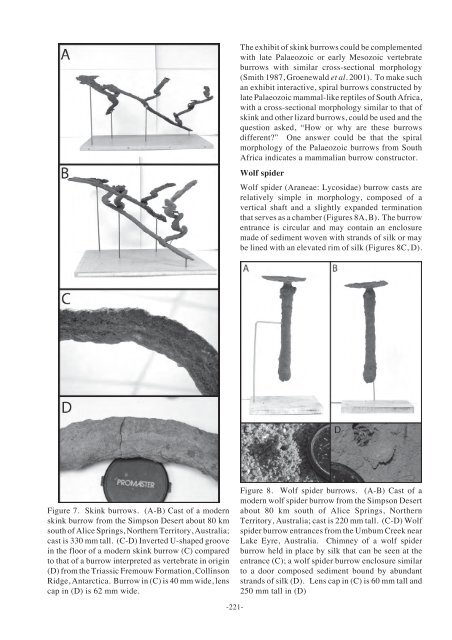Continental trace fossils and museum exhibits - Geological Curators ...
Continental trace fossils and museum exhibits - Geological Curators ...
Continental trace fossils and museum exhibits - Geological Curators ...
You also want an ePaper? Increase the reach of your titles
YUMPU automatically turns print PDFs into web optimized ePapers that Google loves.
The exhibit of skink burrows could be complementedwith late Palaeozoic or early Mesozoic vertebrateburrows with similar cross-sectional morphology(Smith 1987, Groenewald et al. 2001). To make suchan exhibit interactive, spiral burrows constructed bylate Palaeozoic mammal-like reptiles of South Africa,with a cross-sectional morphology similar to that ofskink <strong>and</strong> other lizard burrows, could be used <strong>and</strong> thequestion asked, “How or why are these burrowsdifferent?” One answer could be that the spiralmorphology of the Palaeozoic burrows from SouthAfrica indicates a mammalian burrow constructor.Wolf spiderWolf spider (Araneae: Lycosidae) burrow casts arerelatively simple in morphology, composed of avertical shaft <strong>and</strong> a slightly exp<strong>and</strong>ed terminationthat serves as a chamber (Figures 8A, B). The burrowentrance is circular <strong>and</strong> may contain an enclosuremade of sediment woven with str<strong>and</strong>s of silk or maybe lined with an elevated rim of silk (Figures 8C, D).Figure 7. Skink burrows. (A-B) Cast of a modernskink burrow from the Simpson Desert about 80 kmsouth of Alice Springs, Northern Territory, Australia;cast is 330 mm tall. (C-D) Inverted U-shaped groovein the floor of a modern skink burrow (C) comparedto that of a burrow interpreted as vertebrate in origin(D) from the Triassic Fremouw Formation, CollinsonRidge, Antarctica. Burrow in (C) is 40 mm wide, lenscap in (D) is 62 mm wide.Figure 8. Wolf spider burrows. (A-B) Cast of amodern wolf spider burrow from the Simpson Desertabout 80 km south of Alice Springs, NorthernTerritory, Australia; cast is 220 mm tall. (C-D) Wolfspider burrow entrances from the Umbum Creek nearLake Eyre, Australia. Chimney of a wolf spiderburrow held in place by silk that can be seen at theentrance (C); a wolf spider burrow enclosure similarto a door composed sediment bound by abundantstr<strong>and</strong>s of silk (D). Lens cap in (C) is 60 mm tall <strong>and</strong>250 mm tall in (D)-221-
















